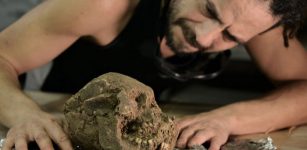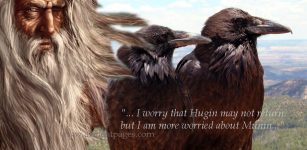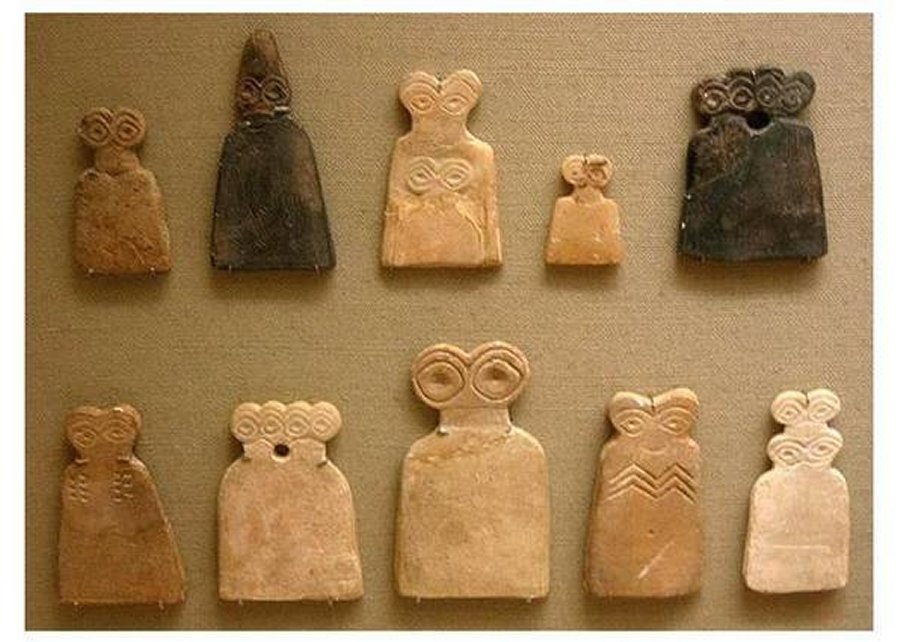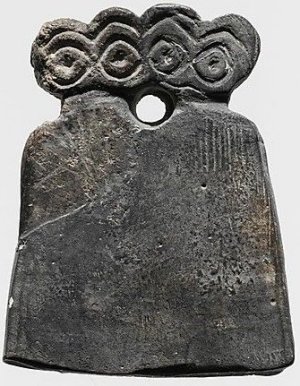Remarkable Ancient Statues From The Eye Temple – Unique Legacy From Tell Brak, Syria
A. Sutherland - AncientPages.com - These remarkable statues with over-seized eyes raise some very intriguing questions.
Why have no similar eye idols been found in any other region? Who were these strange beings with huge staring eyes?
The eye idols of Tell Brak have no parallels, in either Syria or Mesopotamia and they could help us answer important questions of the history of the region.
Tell Brak idols. Image credit: collector-antiquities.com
Unfortunately, due to the troubled situation in Syrian, the eye idols are now on the emergency red list of Syrian cultural objects at risk.
Not much is known about the origin and nature of these remarkable eye idols.
The figures made of stone and having incised eyes were excavated at Tell Brak, where hundreds were found in a building now called the Eye Temple.
The idols vary in size from about 3 to 6 cm in height and are made of either white or black alabaster.
Tell Brak, located in the Upper Khabur region of northeast Syria on the fertile plains near the Tigris river, is one of northern Mesopotamia's largest ancient sites and among the world's earliest cities.
It was first photographed from the air by Fr Pierre Poidebard in the 1920s and was first excavated by Sir Max Mallowan in 1937-8.
From 2011, archaeological research at Tell Brak was funded by a British Academy Research Development Award (BARDA).
In ancient times, Tell Brak was considered an international city. It was home to several civilizations over the centuries, including the Sumerians, Babylonians, Akkadians, and the Mittani's. The city was finally abandoned in c.2000 BC.
"Although Tell Brak is in north-eastern Syria, both the decoration and plan of the Eye Temple resemble that of south Mesopotamian temples, such as those in Uruk and Eridu. Eye symbolism was also popular in Mesopotamia around this time, and eye designs have been found on objects from the Royal Cemetery from Ur as well as in temples.
The Eye Idols of Tell Brak, however, are completely unique and have no parallels, in either Syria or Mesopotamia," the Fitz William Museum informs.
The eye idols discovered at the site date to about 3,300 BC. Many of them are incised with multiple sets of eyes, others with jewelry and still others with representations of "children"-smaller eyes and body carved on the body of the larger idol.
Image credit: collector-antiquities.com
According to historians and archaeologists, the idols are thought to be offerings. It is believed that wide eyes demonstrate attentiveness to the gods in much Mesopotamian art. The reason why so many of these figures were left in the temple, was that they were considered gifts to the gods.
The decoration of the idols varied, and it seems that they may have been personalized. Some of the figures have carved lines and zig-zags on their bodies depicting clothes. There are even examples of group idols representing more than one figure, some of which have a smaller 'child' figure carved onto the front.
The sad part of this story is that the magnificent Tell Brak eye idols are now on the emergency red list of Syrian cultural objects at risk.
The eye idols discovered at the site date to about 3,300 BC. Many of them are incised with multiple sets of eyes, others with jewelry, and still others with representations of "children"-smaller eyes and body carved on the body of the larger idol. Image credit: Museum zu Allerheiligen, Schaffhausen, Switzerland
Several archaeological sites in Syria have been damaged due to bombing and ancient museum's artifacts are looted and burned.
On top of the loss of artifacts, several of Syria's UNESCO World Heritage Sites have reportedly been damaged or destroyed since the conflict began in the spring of 2011!
See also:
Mysterious Sumerian Statues With Big Blue Eyes – A Sign From The Gods
White Temple Of God Anu In Sacred Precinct Of Kullaba At Uruk
Nippur – Holy City Of God Enlil And One Of The Oldest Cities Of Sumer
Sumerian Stele Of The Vultures: Oldest Known Historical Records Carved On Limestone
"Museums, auction houses, art dealers and collectors are encouraged not to acquire such objects without having carefully and thoroughly researched their origin and all the relevant legal documentation. Due to the great diversity of objects, styles and periods, the Emergency Red List of Syrian Cultural Objects at Risk is far from exhaustive. Any cultural good that could have originated from Syria should be subjected to detailed scrutiny and precautionary measures," the world museum community warns.
The destruction of the eye idols of Tell Brak, other artifacts, and archaeological sites is a sad part of human history.
Are we witnessing the end of the Syrian cultural heritage?
Written by – A. Sutherland AncientPages.com Senior Staff Writer
Copyright © AncientPages.com All rights reserved. This material may not be published, broadcast, rewritten or redistributed in whole or part without the express written permission of AncientPages.com
More From Ancient Pages
-
 Mysterious Utah: Prehistoric Ancient Petroglyphs Of Santa Clara River Reserve
Civilizations | Oct 2, 2018
Mysterious Utah: Prehistoric Ancient Petroglyphs Of Santa Clara River Reserve
Civilizations | Oct 2, 2018 -
 Adapa – Why Did The Wise Apkallu Refuse The Gift Of Immortality?
Featured Stories | May 9, 2019
Adapa – Why Did The Wise Apkallu Refuse The Gift Of Immortality?
Featured Stories | May 9, 2019 -
 On This Day In History: Henry II Crowned King Of England – On Dec 19, 1154
News | Dec 19, 2016
On This Day In History: Henry II Crowned King Of England – On Dec 19, 1154
News | Dec 19, 2016 -
 Lady SAS – Ancient Skeleton Of Foreign Woman Found In Palenque – Who Was She?
Archaeology | Apr 11, 2023
Lady SAS – Ancient Skeleton Of Foreign Woman Found In Palenque – Who Was She?
Archaeology | Apr 11, 2023 -
 Mayan Elites Lived In Pre-Hispanic Teotihuacán – New Evidence
Archaeology | Sep 27, 2018
Mayan Elites Lived In Pre-Hispanic Teotihuacán – New Evidence
Archaeology | Sep 27, 2018 -
 The Sistine Chapel Cypher – Secret Messages In The Art Of Michelangelo
Ancient Mysteries | Mar 3, 2018
The Sistine Chapel Cypher – Secret Messages In The Art Of Michelangelo
Ancient Mysteries | Mar 3, 2018 -
 Evil Spirits And Demons Of Marshes And Swamps In Slavic Folklore
Featured Stories | Nov 16, 2016
Evil Spirits And Demons Of Marshes And Swamps In Slavic Folklore
Featured Stories | Nov 16, 2016 -
 Ancient Mysteries Of Chicago: Is The Puzzling Waubansee Stone A Neglected Pre-Columbian Artifact?
Artifacts | Mar 4, 2017
Ancient Mysteries Of Chicago: Is The Puzzling Waubansee Stone A Neglected Pre-Columbian Artifact?
Artifacts | Mar 4, 2017 -
 Lofn ‘Matchmaker’ – Norse Goddess Of Forbidden Marriages Of People Who Wish To Be Loved And Search For Partners
Featured Stories | Mar 25, 2021
Lofn ‘Matchmaker’ – Norse Goddess Of Forbidden Marriages Of People Who Wish To Be Loved And Search For Partners
Featured Stories | Mar 25, 2021 -
 How Many Ice Ages Has The Earth Had, And Could Humans Live Through One?
Featured Stories | Sep 26, 2022
How Many Ice Ages Has The Earth Had, And Could Humans Live Through One?
Featured Stories | Sep 26, 2022 -
 Ancient Chinese Version Of Quipu -Tradition Of Tying Knots Dates Back To Antiquity
Civilizations | Mar 15, 2017
Ancient Chinese Version Of Quipu -Tradition Of Tying Knots Dates Back To Antiquity
Civilizations | Mar 15, 2017 -
 Common Ancestor Of Neanderthals And Humans That Lived 700,000 Years Ago Holds Clues To A DNA Mystery
Archaeology | Feb 22, 2023
Common Ancestor Of Neanderthals And Humans That Lived 700,000 Years Ago Holds Clues To A DNA Mystery
Archaeology | Feb 22, 2023 -
 Discovered – Large Mysterious Structure Hidden Under The Sand In The Sahara Desert – A New Pyramid Or Something Else?
Archaeology | Nov 13, 2019
Discovered – Large Mysterious Structure Hidden Under The Sand In The Sahara Desert – A New Pyramid Or Something Else?
Archaeology | Nov 13, 2019 -
 Discovery Of Stone Age Textiles Sheds New Light On The History Of Clothes Making
Archaeology | Nov 9, 2021
Discovery Of Stone Age Textiles Sheds New Light On The History Of Clothes Making
Archaeology | Nov 9, 2021 -
 Neanderthals And Modern Humans Diverged At Least 800,000 Years Ago
Archaeology | May 17, 2019
Neanderthals And Modern Humans Diverged At Least 800,000 Years Ago
Archaeology | May 17, 2019 -
 Why Was The Iron Age Village Near Elgin In Scotland Suddenly Abandoned And Burned Down?
Archaeology | Jul 29, 2022
Why Was The Iron Age Village Near Elgin In Scotland Suddenly Abandoned And Burned Down?
Archaeology | Jul 29, 2022 -
 DNA Of Nine 13th Century Crusaders Provides A Glimpse Into Soldiers’ Life And Death
Archaeology | Apr 22, 2019
DNA Of Nine 13th Century Crusaders Provides A Glimpse Into Soldiers’ Life And Death
Archaeology | Apr 22, 2019 -
 Acheulian Culture Of Ethiopian Highlands And Their Prehistoric Tool Selection To Make Society’s Life Easier
Archaeology | Jan 10, 2025
Acheulian Culture Of Ethiopian Highlands And Their Prehistoric Tool Selection To Make Society’s Life Easier
Archaeology | Jan 10, 2025 -
 Archaeologists Have A Lot Of Dates Wrong For North American Indigenous History
Archaeology | May 4, 2020
Archaeologists Have A Lot Of Dates Wrong For North American Indigenous History
Archaeology | May 4, 2020 -
 Huginn and Muninn: Powerful Ravens Of Odin, Supreme God In Asgard In Norse Mythology
Featured Stories | Dec 7, 2017
Huginn and Muninn: Powerful Ravens Of Odin, Supreme God In Asgard In Norse Mythology
Featured Stories | Dec 7, 2017




